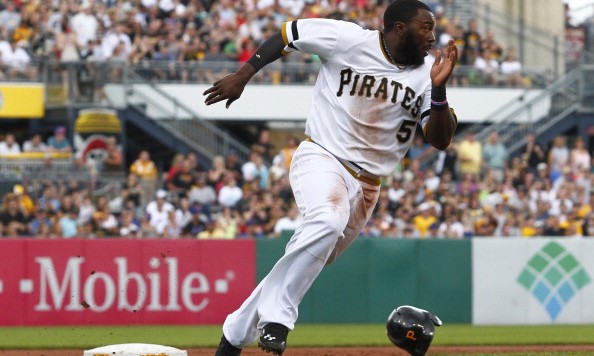Josh Harrison is why we watch sports. In June of 2013, I saw him playing in a Triple-A game in Durham. He played well enough that I came back from the game thinking to myself, “Yeah, I think he’s probably ready to take Brandon Inge’s spot as a utility player.” In early July of 2014, he was a Swiss-Army knife All-Star. The selection was objectively a bit undeserved because he didn’t have a ton of at-bats, a position, or a history of performance, but Harrison certainly had a big first half and was part of the reason the Pirates stayed afloat without a right fielder in the early part of the season. By October, he was the Pirates’ starting third baseman and deservedly receiving MVP votes.
There is no debating Harrison’s 2014 season at this point: it was great. If you want or need a refresher, he hit .315/.347/.490, with 38 doubles, 7 triples, and 13 homers, all while playing solid defense at second, third, and in the outfield corners. That means that Josh Harrison, who opened 2014 as a utility guy, finished second in the NL batting race, and in the top ten in slugging percentage thanks to seventh in the NL in doubles and ninth in triples, despite having 100-150 less plate appearances than guys that played the full season as starters.
Of course, the nature of baseball is such that the only thing that matters now is the question of whether or not he can do it again. This is a really hard question to answer right now, but honestly, there are quite a few positive indicators. Harrison’s minor league numbers looked a lot like his 2014 numbers, albeit with a bit less power (.308/.358/.437 career). That high batting average is important because Harrison doesn’t draw a lot of walks. That means that he’s reliant on a high batting average on his balls in play. For some people, that means that his .353 BABIP would be a red flag; in his three previous stints with the Pirates, he had BABIPs of .304, .259, and .253. Jeff Zimmerman at FanGraphs, though, uses Inside Edge data to calculate expected BABIP (xBABIP) from bunts, ground balls, line drives, fly balls, and player speed, and found that Harrison’s .353 BABIP was awfully close to his xBABIP of .343.
The long and short of it is this: Harrison’s 2014 season came out of nowhere, but there are at least a few reasons to think that even if he can’t quite duplicate that .490 slugging percentage, he can be a productive player in 2015. The Pirates ZiPS projections aren’t posted yet, but the Steamer projections show Harrison at .280/.318/.421, which would make him about a three-win player with decent defense at third base (well, I assume they’re projecting him as a third baseman). Since Harrison doesn’t draw walks, I’m guessing his offensive value will be tied to his ability to hit somewhere between .280 and .300, which his xBABIP and minor league numbers suggest he can do. If that happens, he’ll be fine in 2015, even if he doesn’t quite match the MVP level performance of 2014.
<500 is an ongoing series previewing 2015 for each key Pirate in fewer than 500 words
Photo by Justin K. Aller/Getty Images




















